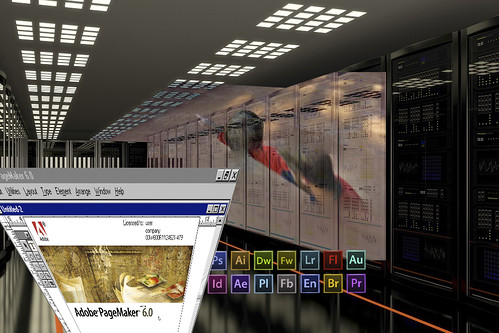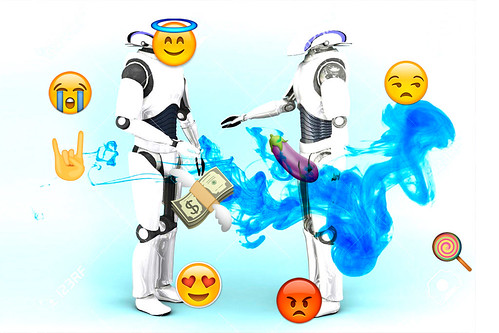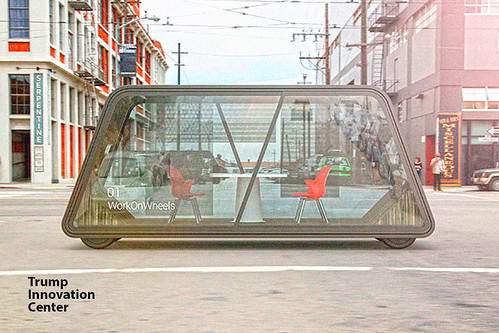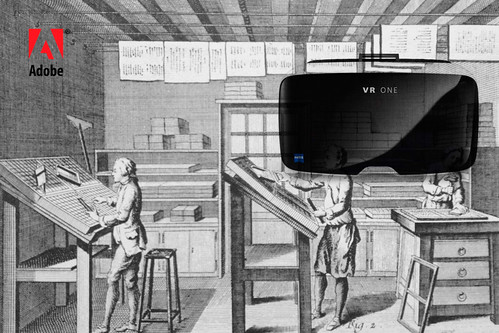Wednesday, 12:00pm
21 December 2016
Ghosts of designbots yet to come
Automated graphic design and the rise of robot creatives – Francisco Laranjo files a critical report from the perspective of Christmas 2025

From our perspective here in 2025, it all seems inevitable, writes Francisco Laranjo. But maybe it wasn’t.
When Adobe released the desktop publishing software PageMaker 6.0 in 1995, it started monitoring and collecting its users’ activity online. In one of the many black-and-white booklets inside its colourful box, it is still possible to read in the fine print that ‘data related to the customers’ use of our software will be collected to improve our products’. After just three years, the company had to build a large compound in the outskirts of Ottawa to store all the information being gathered. By the time Adobe Creative Suite was released in 2003, more than 180 engineers were working exclusively in managing, categorising and processing all the data generated by programs such as Photoshop, Illustrator, InDesign, Acrobat, Premiere Pro, Dreamweaver and After Effects. But this task was consuming too many human resources and was not cost-effective.
As automated tasks ‘to optimise workflow’ became popular among designers – the number of people working in data processing was cut to a third and replaced by bots. These bots could categorise and archive all the data generated by the software packages’ users – mainly graphic designers. On an almost global scale, they were able to produce detailed reports on habits, processes, steps taken, recurrent detours, variations and the final product. When Adobe bought the online portfolio-showcasing platform Behance in 2012, the aim of tracking every designer’s activity was made evident, although disguised as just a ‘boost to empower creativity’ and launch their next product, Adobe Creative Cloud. But the goal was not to empower designers, but to automate profit. The Creative Data Library was ready to be explored. Soon there was no alternative for anyone needing to design but to pay for a subscription. Software had effectively flattened tools, process and output into an inevitable standardisation. The global homogenisation of graphic design and visual culture was a key political conquest to further push consumer control and its respective monetisation.
Opaque algorithms.
Top: An automated odyssey.

Post-Behance boteconomy
In 2013, many software giants received the first lawsuits for unauthorised surveillance from disciplines such as graphic design, film-making, product design and architecture. Settling the disputes for an undisclosed fee, software packages became free as long as its users allowed the monitoring to continue, as articulated in revised terms and conditions. Surveillance, said the group of CEOs at a press conference, is necessary to make products better. The hashtag #boycottAdobe trended worldwide for a few days but surveillance smoothly established itself in the design profession as an inevitability. However, groups of designers and associations were formed in early 2014 who vowed to work only offline, and not to upload any work to platforms that could merge data from multiple sources.
When Adobe launched Adobe Automated Cloud (AAC) in late 2017, the company was already able to offer graphic design services in a completely autonomous way. It had been testing transactions via the distributed database blockchain for eight years. Its design bots traced in real time what was uploaded to Behance. They automatically integrated this data into the ever-changing algorithms of iterative parameters that generated design solutions for clients worldwide. These had been operated by beta-testers since 2009, which worked remotely from various countries, and Adobe charged a fee in every transaction for allowing each designer’s bot access to their design database. This ‘Uberisation’ of graphic design further reinforced the precarious state of the profession in the aftermath of the financial crisis. Designers earned a living in two ways: 1) operating their design bots to fulfil a design service; 2) feeding the centralised design bot network by informing the system about the rationale behind their decisions. The reality of this was expressed in the popular romantic comedy My Boss is a Bot (2018), in which Ashton Kutcher played a designer in midlife crisis, who eventually develops a profoundly moving admiration for his boss.
The designers’ clients – predominantly bots due to the automation of marketing jobs – asked for more human and less digital work. This led to a partnership between Google and Samsung to develop a network of facilities manned by robots. These bots could simulate ‘humanness’ through calligraphy, drawing or screenprinting in jurisdictions with no corporate tax. Designers could request any robot-drawn type and have it delivered in less than three hours by drone. But the feature these beta-testers enjoyed most was that their own bots could be working while they were sleeping, pitching to automated clients … for free. The designer’s job became bot management.
Gigi and Lulu in early 2018.

The new normal
In an interview published in Computer Arts in 2018, Jessica Walsh told an editor bot: ‘It’s only me and Stefan now, plus two robots (Gigi and Lulu). They draw type very well, even on bodies and complex sets. The rest of our branding work has mostly disappeared, as the bots do incredibly cool work. Times have changed … Stefan is definitely not happy.’ Walsh continued: ‘We are lucky to be recognised globally, so we have clients who still support us, but the younger generations don’t really see the difference between my work and Gigi’s … especially because she does it instantly!’ They photographed Gigi and Lulu naked to launch a new service, but she notes that, ‘the bots didn’t get the joke.’
Bruno Brûlé, CEO of Artificial Design Intelligence (ADI) – the corporate merger solution to avoid the bankruptcy of Moving Brands, FutureBrand, Ogilvy & Mather, Brand Union and Wolff Olins – was interviewed around the same time. He said, ‘In the early 2010s all graphic design looked like it was done by robots anyway, so at ADI we are trying to operate in a market that is today dominated by bots.’ All the partners, he said, ‘are now working remotely, as renting studios in big cities has become completely unsustainable. The self-driving IDEO capsules “work-on-wheels” are ideal, because they just roam the cities and designers can have meetings and feed the bots with data at any time without actually owning or renting their workplaces.’ Brûlé finished with a bold statement: ‘If everything looks the same, whether it’s made in LA, London or Seoul, we may as well just let bots do it. Designers are largely not needed any more. Only a few are useful to monitor glitches in the system and help bots make decisions in some rare cases. Our goal is to develop our central bot for a few more years before we let automated technology make every single design decision.’ [Ed’s note: It emerged later that Bruno Brûlé himself was the first in a highly effective new line of robot CEOs. Such managers were perennially popular with bot investors.]
The death of DIY
The design services Fiverr and 99designs closed in 2018. Ultra-cheap, generic design made by designers was no longer profitable. The same was true for studios surfing the waves of rapidly changing trends. Bots had developed detailed databases of style from all historic periods. Clients could browse long lists of designers and studios and order work as if it had been made by them. Some went to court and could receive royalties in every transaction: groups such as Pentagram, Landor and small studios such as Spin and Barnbrook with highly recognisable formal styles. Bots love trendsetters.
Type design was automated with high levels of precision, even though a few type designers were still needed to design typefaces for non-Western languages. ‘What can you design in one month that a bot can’t do in one minute?’ a client famously asked the designer Erik Spiekermann.
Work on Wheels’ production was sponsored by the Trump Innovation Center.

Design for start-ups: case studies
At local government agencies for startups, design bots were recommended for new businesses. Design consultancies were automated, powered by anthropomorphic robots with access to vast governmental and private databases. For example, Sigourney Smedley, a plumber, wanted to have a simple visual presence on wearable devices and on the robot that she assists during working hours. The digital customer service informed her that a free bot would provide a generic logo, mixing traditional plumbing elements such as water, tools and pipes based on a database with 10,000 previous logos per sub-category. To get something more specific, she would have to pay $50 for a graphic designer-assisted bot and have access to premium databases holding historic libraries. For better customisation, she would need to grant access to her social media timelines. The robot asked access to her ‘data traces’. She settled for the free bot.
Many bot services were available at the ACS – Automated Citizen Shop. Here millions of bots compete to pitch case studies on large screens. Or they simply transmit to – and frequently spam – wearable devices pitching business consultancy and unwanted publicity. Stuart Smith was just an example. Since childhood, this piano teacher had had an interest in handcraft and logo design. When he wanted a logo for his business, he thought in a designerly way, being concerned about his audience as well as the integrity of his music and pedagogy. But for an annual subscription of $29.98, a bot would instantly provide a logo, website and badges based on his Facebook account, as well as of five of his pupils. What would have taken him at least a week of hard work was done instantly at high levels of accuracy. He even got a blueprint of a piano for free, which he could 3D print for an extra $100. Among the many premium features of his subscription were regular reports and analytics on the performance of his brand, automated social media management (socialbot), and permanent upgrades to his brand via the company’s award-winning creative algorithm.
Offline education for a ‘toxic profession’
When it became evident that bots increasingly optimised trends and were able to quickly replicate design processes, Times Higher Education rated graphic design as a ‘toxic profession’. Designers were effectively locked out of a system that was designed, updated and upgraded for them. Botdetox™ camps became popular among young generations while established designers refused to communicate online. They allowed only landline phones in their failing studios, sustained by academic positions that were becoming redundant. Nostalgic students and alumni of prestigious design colleges worldwide protested for the right to study design. But the institutions insisted on closing courses: ‘Did none of you read Inventing the Future [by Nick Srnicek and Alex Williams, 2015] ten years ago?’ asked RISD’s president in a statement.
Fierce competition was provoked between thousands of letterpress and screenprinting workshops and robots using the same tools in remote warehouses. Many closed down. Nostalgia for craft and manual labour came at a cost. When stepping down as Dean of the School of Communication at the Royal College of Art, designer Neville Brody stated, ‘At best, graphic design is now a hobby. Graphic design history is literally the future.’
‘Learn the Basics in Italy’ course with VR for All.

Bots for better living
By the time the New York Times best-seller The Automated Life was published in late 2018, nearly half of the technical graphic design schools and courses had closed. All were replaced by Adobebots that with VR headsets could ‘teach Illustrator in a day’. This was part of VR for All – an imperialistic initiative by Mark Zuckerberg’s Facebook Foundation.
Students enjoyed being taught InDesign by Giambattista Bodoni in an Italianate setting without leaving the comfort of their parents’ basement. Design schools were deemed immoral by industry leaders – that is, the managers of the most highly-rated bots. Students did not want to pay high fees to learn something obsolete they could neither practise nor be paid for.
As a result, two types of design schools survived. One, a centralised, manual, nostalgic, craft school. The second, a cooperative of small, nomadic design schools built around systems thinking and political activism. The former mostly focused on the conservation of tradition and history. The latter sought to challenge the infrastructure that shapes and predefines the way people think and live. Meanwhile, the Russell Group had expanded to a global university superpower with nearly complete control of the job market in the wealthiest cities of the Global North. Its chairman declared that the future would continue to be dominated by robotics and bot studies, the most popular disciplines. In the short description downloadable to every device, it was possible to read that the Russell Group ‘encourages cooperation with bots for better living, not the kind of hacktivism that seeks to disturb the normal functioning of our educational systems’.
Beyond denial
Now, in 2025, designers are data managers. Design bots work for and with marketing bots. Graphic designers and the design press have let themselves be regulated by the marketplace. Trying to escape automation, thousands of designers have moved away from big cities to countries where this process is slowed. Others have sought solace in Ecuador, which banned automated labour in 2020. With technological advancements, designers’ lack of interest in infrastructure was revealed to be suicidal. Companies came after graphic designers’ information and they gave it away for badges, stickers and likes.
Designers are now mostly information intermediaries. A devastating gulf has opened up between the residual manual labour of letterpress, screen-printing and calligraphy, and the long, rigorous, research-led and -based design with reflective and critical analysis. The rest – the majority of graphic designers – have disappeared, apart from a few who survive with faithful, technophobe clients.
The design practice that is not automated is the design that is not easily replicable. It bases its methods and problematisation on many disciplines and detailed cultural, social and political analysis of the context in which it works. And – importantly – it is one that constantly considers and involves those who will be affected by it, debating its consequences in an open manner. So far, bots are still flawed in developing such an approach. But not for much longer. Democratisation, accountability and transparency continue to be increasingly difficult utopias. A key issue continues to be our difficulty in understanding and changing the way algorithms make their biased decisions. They reaffirm the Western canon of good design, serving interests with increasingly obscure and inaccessible criteria. These concerns apply to the majority of creative disciplines – graphic design is by no means alone.
In 2016, anthropologist Lucy Suchman announced at the AI Now conference that the fact that ‘we pay coders more than childcare workers is less about skills and more about how we value the work’. The same can be said of education, culture, and of course, design. So it is not that there were not enough jobs for designers at that time, but that they were simply undervalued. Retrospectively, many disciplines regret overlooking Suchman’s writings since her book Plans and Situated Actions in 1987 and her subsequent research on automation and drone warfare. Design is no exception.
Automation was looming in 2016. But designers were too busy funding nostalgia on Kickstarter via good old Modernism. Trolling OS icons on Dribbble was more entertaining than debating and dealing with a political issue that would shape the way we now work, think and live. For most designers, it is all far too late.
Francisco Laranjo, graphic designer, researcher, London
Eye is the world’s most beautiful and collectable graphic design journal, published quarterly for professional designers, students and anyone interested in critical, informed writing about graphic design and visual culture. It is available from all good design bookshops and online at the Eye shop, where you can buy subscriptions and single issues.
Links
Open Democracy: The robot economy may already have arrived
Sage Journals: Seeing without knowing: Limitations of the transparency ideal and its application to algorithmic accountability
AAAI Publications: Gaudii: An Automated Graphic Design Expert System
DesignScape: Design with Interactive Layout Suggestions
Evgeny Morozov in the Guardian: ‘Data populists must seize our information – for the benefit of us all’
